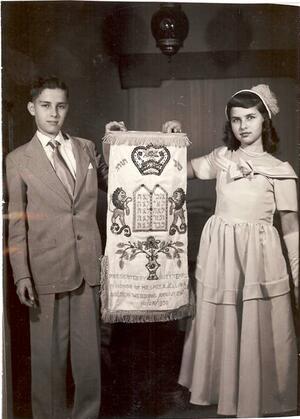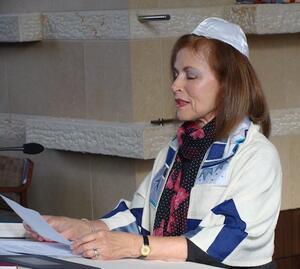Rebecca Lubetkin's 60th Bat Mitz-versary
“It’s funny how practices that seem way out in one generation become so commonplace in another that people wonder what took so long. With the benefit of hindsight, the change looks like a no-brainer, like the natural order of things, making it hard to imagine the struggle that was required to make it happen.”
So begin the words Rebecca Lubetkin recently spoke to her congregation, Congregation Beth El in South Orange, NJ. Just weeks after attending her granddaughter’s bat mitzvah, Lubetkin did something unusual for a grandmother: She mounted the bimah to chant the same haftorah she’d chanted a full 60 years earlier … at her own bat mitzvah in 1951. And she shared this story with the family, friends and congregants seated before her.
“My Bat Mitzvah, on a Shabbat morning in 1951, is considered a very early one,” she continued. “Yet the first recorded Bat Mitzvah in the U.S. took place back in March, 1922, when Judith, the daughter of Mordecai Kaplan, became a Bat Mitzvah. It was still rare 30 years later when I became of age; and then it took yet another 25 years after my Bat Mitzvah before it became routine. Why did we not see a groundswell of interest just waiting to get in once the doors opened?”
After listing the many “seemingly insurmountable obstacles” that stood in the way of girls becoming a Bat Mitzvah, “what happened in 1951,” Lubetkin asked, “that allowed me to become a Bat Mitzvah on a Saturday morning?”
Her answer: “while I don’t know for sure what was responsible, I have a good idea of what was not.”
“It was definitely not a reflection of the rabbi’s personal conviction. The Congregation had never had a Bat Mitzvah of any kind before mine. The rabbi never allowed another Bat Mitzvah on a Shabbat morning. He retired in the early 1990s, 40 years later, still not having accepted what had become commonplace.”
Reflecting on what might have led to her Bat Mitzvah, Rebecca recalls “the fact that [her] mother, Jessica Levin, remembered feeling profound sadness having being denied this privilege. As a 12-year-old in 1924 in a Conservative synagogue, she longed to be allowed to express publicly her spiritual connections. She saw her five brothers acknowledged for their coming of age, a milestone for which they showed mostly disinterest; while she, with the same religious education and her enormous passion, was not recognized.”
But in the end she surmises that “what it really came down to was expediency and logistics: expediency because (the rabbi) was unwilling to stand up to my parents. Logistics due to the fact that I had a twin brother, Hank. My parents were unwilling to leave me out altogether or to have two separate services, one on Friday night and one on Saturday.”
Returning to the ceremony itself, Rebecca recalls that “we each delivered a speech. Our mother wrote mine. And here is the interesting thing: while insisting on an event traditional for only males, her speech reflected traditional female aspirations for me, valuing the occasion for inspiring me to create a Jewish home. After having me give thanks for this great honor, she had me add: ‘I will also pay particular attention to my special province—what makes a home truly Jewish, in order to fulfill the concept of Aishet Hayil, a woman of worth.”
Her mother also dressed her. “She wanted me to look feminine, despite my masculine role. And also to be dressed modestly. She decided that she would have to have a dress made. So off we went to a bridal shop, where she described what she wanted for her 12-year old: a full-length satin gown in light blue with matching elbow length gloves. I needed a head covering, but a kippah was for boys. So she designed a hat in matching satin decorated with tulle. On my feet would be matching light blue satin slippers.”
The congregation gave her brother a wine cup and she was presented with a diminutive white leather-bound “Bride’s Bible. ”It was very clear what was expected of me as I entered Jewish adulthood.”
Lubetkin who today considers herself, among other things, a Jewish feminist activist, has over the decades been an active force for the changes for women at her Conservative synagogue, Congregation Beth El. These include aliyot, being counted in minyan and calling both men and women by both their father’s and mother’s names; “paving the way,” she writes, “for a woman rabbi.”
Rebecca Lubetkin’s Bat Mitzvah story is included in “Bat Mitzvah Comes of Age,” a traveling exhibit organized by Moving Traditions and the National Museum of American Jewish History. To learn more about the exhibit, visit movingtraditions.org/programs/bat-mitzvah-comes-of-age.







